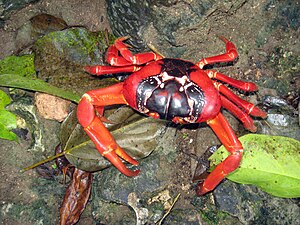Christmas Island Crab
| Christmas Island Crab | ||||||||||||
|---|---|---|---|---|---|---|---|---|---|---|---|---|

Red Christmas Island Crab |
||||||||||||
| Systematics | ||||||||||||
|
||||||||||||
| Scientific name | ||||||||||||
| Gecarcoidea natalis | ||||||||||||
| ( Pocock , 1888) |
The Christmas Island crab ( Gecarcoidea natalis ), also known as the red land crab , is one of around 20 species of land crab described . It occurs exclusively on Christmas Island, which belongs to Australia, and the Coconut Islands in the Indian Ocean , so like many representatives of the land crabs it is an island end . About 50 million crabs of this species populate the island. Almost a century ago, before phosphate mining began, the estimated population was over 100 million.
description
The bright red color of the carapace is striking and measures about 11 to 12 cm in diameter in an adult crab. This is why this species is also known as the "red land crab". In some cases there are also orange-colored variants, more rarely a purple color can be observed. The four pairs of striding legs are of equal length.
The males of the Christmas Island crabs grow larger than the females and have larger claws that they use in rivalry and turf fights with other males. The females have a much wider abdomen than the males, which, like all crabs, is folded and plays an important role in laying eggs. In the young crabs this sexual dimorphism is not yet pronounced, the wider abdomen of the females only becomes visible in the third year of life after a molt.
nutrition
The food of the Christmas Island crab consists mainly of fallen leaves ( detritus ) from the rainforest. The crabs play a similar ecological role in processing the plant remains as earthworms elsewhere , which do not exist on Christmas Island. Fruits and flowers that have fallen down also serve as food. The animals prefer fresh leaves, but thanks to their high population density they also completely free the ground from withered leaves in places.
They also often chop up and eat seedlings and young plants. Their role as “gardeners” in the composition of tropical island vegetation is the subject of research.
Animal food is not spurned. Dead crabs are eaten just as much as bird carcasses or the large agate snail ( Achatina fulica ) that has been introduced to Christmas Island . All organic waste is disposed of in the vicinity of human settlements.
Reproduction
Christmas Island crabs only reach sexual maturity after four to five years. What is remarkable is the fact that at a certain point in November (the beginning of the rainy season) all sexually mature crabs migrate from the forest to the coast at the same time. The males first migrate to the coast and ingest sea water, then they return to the coastal forest. There the males dig mating holes that they defend against rivals. The mating, which lasts about 20 minutes, takes place mainly in these caves. Then the females migrate to the seashore and leave the fertilized eggs to the sea. The young animals hatched from the eggs then migrate from the coast into the forests in a mass migration. The crab migration is a major attraction on Christmas Island. On their way across the island, the crabs overcome the greatest obstacles and steer purposefully towards the sea. To this day it is not clear how they orient themselves.
Enemies
The Christmas Island crab currently has no natural predators and few food competitors on the ground. Occasionally there are arguments with the palm thief ( Birgus latro ), a large land hermit crab . It is possible, however, that the Maclear rat ( Rattus macleari ), which died out in 1903 due to the introduction of diseases, had decimated the land crab population by then. Reports about the migration of huge flocks of Christmas Island crabs to the beach only exist from the 20th century.
However, since the 1990s a threat to crab populations has emerged. It is the yellow spinner ant ( Anoplolepis gracilipes ) that was probably introduced from Africa . This aggressive ant burns the crabs' eyes with its poison, causing them to go blind. Blind crabs can no longer feed and die within three days. Like other introduced species of ants, the yellow spider ant spreads relatively quickly via super colonies and has narrowed the habitat of the Christmas Island crab despite various attempts at control by humans.
Commensals
The subject of further investigations, which are mainly carried out by evolutionary researchers and geneticists, is the association of the fruit fly Lissocephala powelli with the Christmas Island crab.
Web links
- Crab info on the Christmas Insel homepage (English)
- Two-minute video
- Geo-article about the annual crab migration
- Information from the Australian Ministry of the Environment (English; with PDF files on migration and life cycle of Gecarcoidea natalis for download)
literature
- S. Morris, U. Postel, et al. a .: The adaptive significance of crustacean hyperglycaemic hormone (CHH) in daily and seasonal migratory activities of the Christmas Island red crab Gecarcoidea natalis. In: Journal of Experimental Biology. 213, 2010, p. 3062, doi: 10.1242 / jeb.045153 . (Research article on the daily and seasonal migratory activities of the Christmas Island crab; English)

